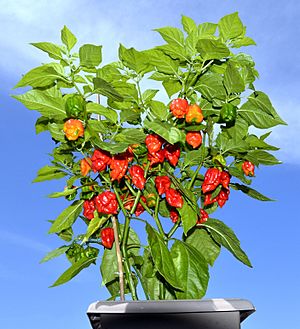Hottest chili pepper facts for kids
Since the 1990s, especially in the US, UK, and Australia, people have been competing to grow the hottest chili pepper. Chili peppers that measure over 1,000,000 Scoville Heat Units (SHU) are called "super-hots." The Scoville scale measures how spicy a pepper is. Some past record holders for the hottest pepper, recognized by Guinness World Records, include the ghost pepper, Infinity chili, Trinidad Moruga scorpion, Naga Viper pepper, and Trinidad Scorpion Butch T. The current record holder, named in 2017, is the Carolina Reaper. It measures more than 1.6 million SHU!
Contents
How the Hottest Peppers Were Discovered
Before the early 1990s, only two peppers were known to be hotter than 350,000 SHU: the Scotch bonnet and the habanero. In 1994, a farmer from California named Frank Garcia grew a new type of habanero called the Red Savina. This pepper measured 570,000 SHU. At the time, people thought this was as hot as a chili pepper could get.
In 2001, Paul Bosland, a scientist from the Chile Pepper Institute at New Mexico State University, visited India. He went there to find samples of the ghost pepper, also known as Bhut Jolokia. This pepper was traditionally grown in Assam, India, and was being studied by the Indian army for its strong properties. When Bosland grew and tested the ghost pepper, he found it measured over 1 million SHU. This discovery really changed what people thought was possible for pepper heat.
Later, in 2006, the Dorset Naga, a type of Naga Morich, was said to be the hottest. Then, in 2012, the Chili Pepper Institute announced the Trinidad Moruga scorpion as the new hottest pepper. It was measured at 2 million SHU, which was the first time any pepper reached that level! Many of the super-hot peppers grown today are mixtures of chilies that originally came from India and Trinidad.
What Are Super-Hot Peppers?
The new, extremely hot peppers are called "super-hots." These are peppers that measure over 1 million SHU on the Scoville scale.
In 2015, Paul Bosland and his team used special microscopes to study these peppers. They found that most peppers store their spiciness, called capsaicin, mainly in the white part inside, called the pith. But super-hot peppers store a lot of capsaicin in their flesh too, not just the pith. This means that even if you remove the pith and seeds from a super-hot pepper, it will still be very spicy. Super-hots not only have more capsaicin, but they also store it differently. They have extra tiny sacs, called vesicles, on the outer part of the fruit, as well as on the inner part where the seeds attach. This is why they have such incredibly high Scoville heat units.
Pure capsaicin is the hottest it can get, at 16 million SHU. But peppers themselves won't reach that level because the capsaicin is mixed with other plant parts. In 2016, Bosland thought it might be possible to grow a pepper that reaches 3 or 4 million SHU. Because super-hots are so hot, you should always handle them carefully. Wear gloves and eye protection, as even touching a single seed can cause a burning feeling on your skin.
The Competition to Be the Hottest
Chili growers compete very strongly with each other to grow the world's hottest pepper. The biggest achievement for them is to be listed in Guinness World Records.
Why Hot Peppers Are Important
According to Paul Bosland, these records are mostly important for people who sell hot sauces. In 2013, making and selling hot sauce was one of the fastest-growing businesses in the US, worth about $1 billion. Companies know that they can sell more sauce if it has a world-famous chili on the label. Being able to say your pepper holds the record can make a new product very popular. For example, the person who grew the Naga Viper pepper, which was the record holder for a short time in 2011, earned $40,000 in just one month from selling seeds and sauces. The grower of the Trinidad Moruga scorpion, which held the record in 2012, made $10,000 in two days just from selling seeds.
Selling seeds is also a big way for growers to earn money. In 2013, you couldn't buy super-hot seeds from regular stores. You could only get them from the growers themselves or from small, special sellers. A single Scorpion pepper pod at a farmers' market could sell for one dollar. Some very special hot sauce, said to have 16 million SHU, once sold for $595 a bottle! People who love chilies, sometimes called "chiliheads," even make YouTube videos of themselves eating super-hot peppers. They do this for fun or to show how hot a certain pepper is.
In Nagaland, India, the yearly Hornbill Festival even has a ghost pepper-eating contest!
The Hottest Peppers in the World
Record Holders
Between 2007 and 2012, Guinness World Records looked into 25 different claims for the world's hottest pepper. As of 2019, Guinness officially lists the Carolina Reaper as the hottest pepper.
| Pepper Name | Picture | Type of Pepper | Who Grew It | Country | Scoville Units (SHU) | Guinness Record Year |
|---|---|---|---|---|---|---|
| Carolina Reaper |  |
C. chinense | Ed Currie | US | 1,641,183 | 2017 |
| Trinidad Scorpion Butch T | 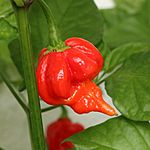 |
C. chinense | Butch Taylor Marcel de Wit |
US Australia |
1,463,700 | 2011 |
| Naga Viper |  |
C. chinense × C. frutescens | Gerald Fowler | UK | 1,382,000 | 2011 |
| Trinidad Moruga scorpion | 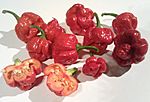 |
C. chinense | Local variety | Trinidad | 1,200,000 | 2012 |
| Infinity | C. chinense | Nick Woods | UK | 1,176,182 | 2011 | |
| Ghost pepper | 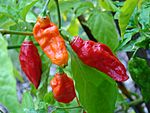 |
C. chinense × C. frutescens | Local variety | India | 1,001,000 | 2007 |
| Red Savina | 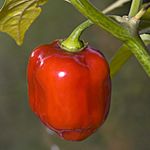 |
C. chinense | Frank Garcia | US | 570,000 | 1994 |
Other Very Hot Peppers
Many other peppers are incredibly hot, even if they haven't held the official Guinness record.
| Pepper Name | Picture | Type of Pepper | Who Grew It | Country | Claimed Scoville Units (SHU) | Introduced |
|---|---|---|---|---|---|---|
| Pepper X | C. chinense | Ed Currie | US | 3,180,000 | 2017 | |
| Dragon's Breath | C. chinense | Neal Price | UK | 3,000,000 | 2017 | |
| Chocolate 7-pot | C. chinense | Local variety | Trinidad | 1,800,000 | ||
| Komodo Dragon | 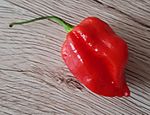 |
C. chinense | Local variety | UK | 1,400,000 | 2015 |
| Armageddon | C. chinense × C. frutescens | Local variety | UK | 1,300,000 | 2019 | |
| Dorset Naga (a type of Naga Morich) |
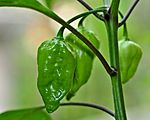 |
C. chinense | Joy and Michael Michaud | UK | 1,201,000 | |
| Naga Morich |  |
C. chinense | Local variety | India and Bangladesh | 1,000,000 |


